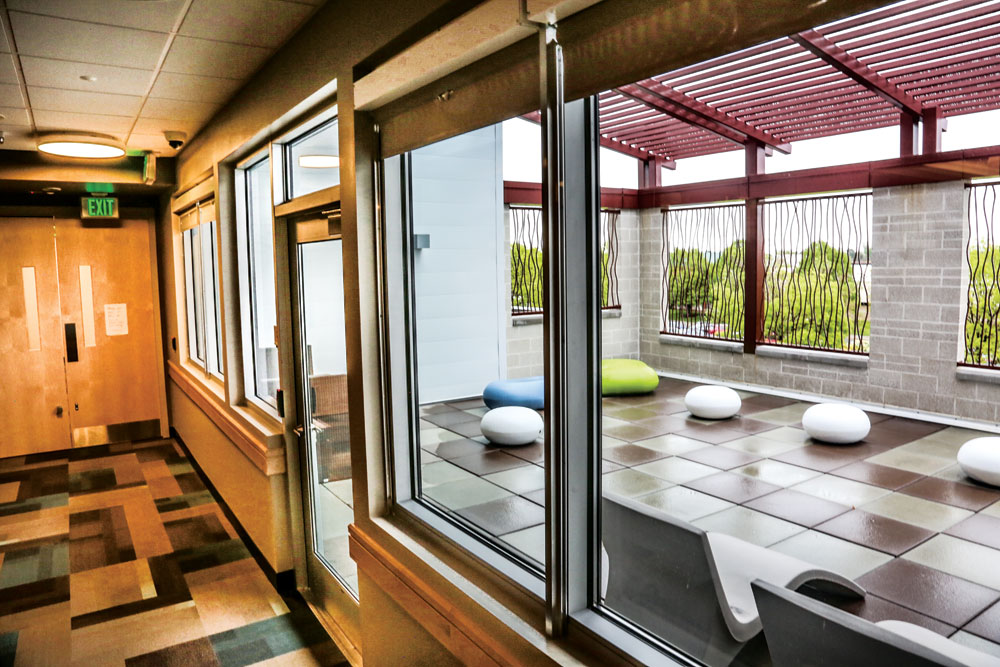
A former patient chats with Dr. O’Melia on one of the residential floors. “If you notice something, say it, regardless of the reaction,” they advise parents. “There’s a high chance your child could lash out or break down or say, ‘Yes, I need help.’ But just saying that you see what’s happening is huge.”

ERC recently opened its new 62,00sf, 72-bed state-of-the-art behavioral health hospital in Lowry to offer inpatient and residential treatment. The new facility offers medical, psychological and psychiatric care. Patients and staff shared insights that contributed to design decisions, ensuring that the new space supports recovery in every possible way.
Editor’s note: Per the 2017 revision to the Associated Press Style Guide, this story employs the gender-neutral singular pronouns “they” and “their,” which is the preference of the subject in this article, written with the assumed name Mary Smith.
“It was a slow suicide,” says Mary Smith a former anorexia patient. “My eating disorder was not about being thin.” They talk openly about a lifelong struggle with mental health issues, beginning with various self-destructive behaviors and attempted suicide in high school. In college, these tendencies toward self-harm manifested themselves in an eating disorder. “In my eyes, trauma was my eating disorder… I didn’t want to be in my body or be here.” Today, this patient exudes a serenity and quiet joy in complete contrast to the person they used to be; however, it took years to arrive at this place.

The bathrooms were designed to allow a clean line of sight for clinicians.

The mirrors are made out of a material that is not glass to give an added layer of safety to patients. This material also causes some distortion that allows the image to become clearer the closer patients move to the mirror. In return this makes it challenging for patients to focus on their physical image.
Anne Marie O’Melia, a Lowry resident and physician at the Eating Recovery Center (ERC) in Lowry, says eating disorders are a complex mix of both medical and psychological factors, and may include a range of issues and personality traits. Among these traits are: sensitivity to change or conflict, difficulty being decisive, perfectionism, and being very driven. Personal trauma or loss are also common factors. Although more women than men receive treatment, O’Melia says preadolescents with eating disorders are evenly divided by gender, “with a strong overlap of autistic and obsessive-compulsive traits.”
For an eating disorder to manifest, says O’Melia, this genetic predisposition often combines with a social influence that triggers it. “Culturally normal behavior like a diet or a health plan might click it on and the brain hijacks the individual; often, that first diet is the trigger.”
“We do need to conceptualize this as a true illness. There’s a wide perception that this is something people choose. People never choose an eating disorder. These are temperamentally at-risk people and it is biologically driven as well…in anorexia about 75% of the risk can be traced to genes…the heritability of all eating disorders is as high as for any other mental illness…In fact, schizophrenia and bipolar disorder have a lower heritability,” says O’Melia.
Sharing regular dinnertime and accompanying mealtime conversations is important, according to O’Melia. “This clearly reduces eating disorders. Share your meal. Share your day. Leave the tv off [during meals].”

Quotations from patients adorn many of the walls, including this one in a group therapy space. Patients selected the facility’s artwork as well.
Smith says she was admitted four times to ERC before really getting better. “I was doing all the things I was supposed to. For me, though, a big thing that kept me sick was that I wasn’t out at all. I am gay and I also identify as nonbinary…trans people are four times more likely to suffer from an eating disorder at some point. If you feel like your body isn’t yours, why would you want to be in it?…There are layers of complexity to this disorder,” they say.

Natural light enters the building through walls of windows along an enclosed patio. Patio access is controlled and secured, to prevent self-harm and protect patient privacy. To reduce noise throughout the building, architects employed sound baffles.
That complexity means eating disorders may manifest in a variety of ways, including not only anorexia nervosa but also compulsive overeating and bulimia. As with most illnesses, the outcomes improve with early detection. O’Melia recommends initiating a conversation with your pediatrician or family physician if you have concerns, and suggests looking for common warning signs such as: avoiding activities because food will be present; being rigid about food or having “good” and “bad” foods; becoming obsessive or withdrawn. Furthermore, she says, families need to be intentional about the messages they send their children, and take care not to equate success with thinness.

In the community room, patients can socialize and work on jigsaw puzzles, a favorite activity
“It’s a slippery slope, and we want kids to develop values and goals quite separate from their appearance and size and shape,” she observes. “Listen to your gut,” O’Melia advises, “and don’t wait for lab tests to get bad…a normal lab result is not necessarily reassuring in this population.”
Smith says their family did not have the skills or understanding to provide help; somehow, though, while careening toward a slow death that first semester in college, they had the self-awareness and strength to seek help. “You need to start conversations about mental health in general….normalizing therapy and normalizing mental health…and I think a really big indicator to show that you care about your child’s mental health is to take care of your own….Had I seen my parents go to therapy, I would have been much more open to therapy….Don’t make it a punishment; make it a part of a routine,” says Smith, when asked for advice to parents.
Many myths around eating disorders endure and may serve as barriers to people getting help. The National Eating Disorders Association (NEDA) website states, “Eating disorders have historically been associated with straight, young, white females; in reality, they affect people from all demographics and are not caused by any single factor.” Eating disorders do not discriminate by ethnicity or race, but fewer people of color and men tend to seek treatment. O’Melia says another myth is that treatment is unaffordable and inaccessible. She says insurance pays for about 97% of treatment, and adds that “Full recovery is not only possible, it is expected.”
ERC opened its flagship facility in Denver in 2008. According to ERC, it is the largest national eating disorder treatment provider, with 30 facilities nationally. Fully 85% of its Denver patients come from out of state.
“The reality is, if you want to be here, you have to learn to be in your body. And that’s where recovery comes in. I’ve lost people and friends in my life. I’ve almost lost my own life multiple times,” says Smith, who now works with youth in the queer community, hosting holistic healing events and producing all-inclusive fashion shows that count ERC among its sponsors. “ERC was there when I was sick and they still are there, though I’ve been well for five years…they didn’t just save my life in the moment.”
For more information including screening tools, visit the NEDA website: https://www.nationaleatingdisorders.org or the ERC https://www.eatingrecoverycenter.com/



0 Comments